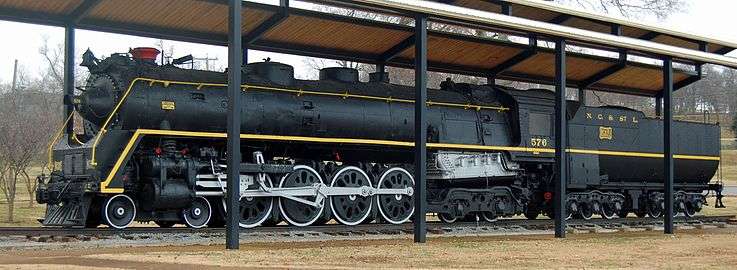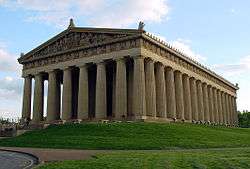Centennial Park (Nashville)
| Centennial Park | |
|---|---|
|
The Parthenon is the centerpiece of the park. | |
| Type | Public park |
| Location | Nashville, Tennessee |
| Coordinates | 36°08′56″N 86°48′43″W / 36.149°N 86.812°W |
| Area | 132-acre (0.53 km2) |
| Operated by | Metropolitan Nashville Department of Parks and Recreation |
Centennial Park is a large urban park located approximately two miles (three km) west of downtown Nashville, Tennessee, across West End Avenue (U.S. Highway 70S) from the campus of Vanderbilt University and adjacent to the current (2016) headquarters campus of the Hospital Corporation of America. Blacks were banned from the park until the 1960s.
This area of Nashville, popular to young professionals, is known as the West End. Its vicinity has seen tremendous recent growth, including two very nearby large-scale apartment developments—Elliston23 and ParkCentral.[1][2]
History
The 132-acre (0.53 km2) park was originally farmland that had belonged to Anne Robertson Johnson Cockrill (1757–1821).[3] She was the first teacher in the state and sister of General James Robertson (commonly referred to as the "Father of Middle Tennessee").[3] She and her family came from Wake County, North Carolina to Fort Nashborough (now Nashville) in the Donelson Flotilla, led by Andrew Jackson's wife Rachel's father, John Donelson. They stopped for the winter in 1776 when the river iced over and, while the men were out hunting, Indians attacked Fort Wautaga. Anne, although wounded, led the women in a bucket brigade of boiling wash water to fend off Dragging Canoe and other Chickamauguan Indians attempting to set fire to the fort, ultimately driving off the Indians and saving the fort and families. For her valor, she was given a land grant for the land which was turned into the state fairgrounds after the Civil War.
From 1884 to 1895, the site served as a racetrack and was known as West Side Park. In 1897, it was the site of the Tennessee Centennial and International Exposition and was renamed Centennial Park. After the exposition ended, most of the building and exhibits (with the exception of a full-scale model of the Athenian Parthenon) were dismantled, leaving in its place a landscaped open area with a small artificial lake (named "Lake Watauga" after the region, then in western North Carolina, where many of Nashville's early settlers moved from), sunken gardens, and a bandshell. This area became an important recreation site for white Nashvillians; "Jim Crow" laws forbade its use by African Americans until the 1960s, which resulted in disagreements leading to the closure of the park's swimming pool to prevent it from integrated. Buildings associated with the pool ultimately reopened as an arts center.


The Parthenon replica, built largely out of plaster as a temporary exhibit building (the Nashville pavilion of the Centennial Exposition) began to fall into disrepair and was proposed for demolition on several occasions, but public sentiment in favor of this symbol of Nashville as the "Athens of the South" precluded this. Finally, in the 1920s it was agreed to replace the temporary plaster building with a permanent, concrete and steel replacement which remains today and has been refurbished on several occasions. It functions today primarily as an art gallery. It contains a statue of Pallas Athena, said to be the largest indoor sculpture in the Western world, which was commissioned by the city and realized by the renowned Nashville sculptor Alan LeQuire. Owing to the completeness and the multiple color surface painting (called polychrome), this replica is arguably closer to what the Athenians saw than are the current ruins in Athens. From 1954 to 1967, the Parthenon was the backdrop for an enormous nativity scene sponsored by the now-defunct Harveys department store. The scene was approximately 280 feet (85 m) long, 75 feet (23 m) deep and was flooded with colorful lights. However, the Italian firm from which the Harvey family had purchased it went out of business soon afterwards. Hence, no authorized repairs, technical support, or even reliable guides to proper maintenance of the fixtures were available. By 1968, the fixtures were in such serious disrepair the nativity could not be exhibited. Financial responsibility became too much for Harvey’s and the city of Nashville and the scene was sold to a Cincinnati shopping center. According to the Nashville Banner, the nativity scene was shown only two Christmas seasons in Cincinnati before it collapsed and was discarded.
Centennial Park is the site of the climactic scene in Robert Altman's Nashville, a picture beloved of many film critics. The park's bandshell is also the site of the annual "Shakespeare in the Park" presented by the Nashville Shakespeare Festival from late August to early September.

There were many mature shade trees in the park until the 1998 Nashville tornado outbreak; most of them were damaged or destroyed in the storm. The park was also the site of the storm's sole fatality, a Vanderbilt ROTC cadet.[4] Since then, the park and other areas of outdoor gathering in the Nashville area have been equipped with storm-warning sirens.
On November 11, 2005, Centennial Park became Nashville's first wireless internet park by offering free Wi-Fi internet access to park patrons.
In 2015, workers relocated the source of the spring that was a major feature during Anne Robertson Johnson Cockrill's ownership and excavated it. It is a significant feature to the land that had been capped and piped to the sewer for 100 years piping more than 100 gallons of water per minute.[5]
On August 26, 2016, as part of Women's Equality Day, a monument by Alan LeQuire was unveiled in the park, featuring depictions of Carrie Chapman Catt, Anne Dallas Dudley, Abby Crawford Milton, Juno Frankie Pierce, and Sue Shelton White.[6][7]
The park also contains a recreation center and is the home of the administrative offices of the city's Department of Parks and Recreation; however, these are currently in the process of moving to the East Bank of the Cumberland River adjacent to LP Field in the offices of the former Nashville Bridge Company.
References
- ↑ "Southern Land breaks ground on Elliston 23," Nashville Post, Aug. 30, 2011
- ↑ "ParkCentral Under Construction in Nashville’s West End," Multi-Housing News, Sept. 7, 2012
- 1 2 Bucy, Carole Stanford. "Ann Robertson Johnston Cockrill". The Tennessee Encyclopedia of History and Culture. Tennessee Historical Society and the University of Tennessee Press. Retrieved August 27, 2016.
- ↑ Ian Demsky. "Tornado sirens go unheard in many areas". The Tennessean, June 9, 2004.
- ↑ Ferrier, Dennis. "Underground spring to help transform Centennial Park". Retrieved 2015-05-06.
- ↑ 5:33 PM, Aug 26, 2016. "Women's Suffrage Monument Unveiled - Story". Newschannel5.com. Retrieved 2016-08-27.
- ↑ "Nashville's Newest Monument Celebrates State's Role In Women's Winning The Right To Vote". Nashville Public Radio. Retrieved 2016-08-27.
- Johnson, Leland R. (1986). The Parks of Nashville: A History of the Board of Parks and Recreation. Nashville: Metropolitan Nashville Board of Parks and Recreation.
